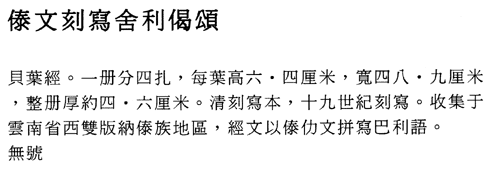 |
|
|
 |
Narrative Verses
of Sariputra in Dai Script Qing
dynasty (1644�1911), undated, ca. 19th century Translated
from the Pali Abhidhamma-pitaka From
Xishuangbanna, Yunnan Province 4
bundles of palm leaves, each leaf: approx. 6.4 x 48.9 cm; height of stacked
bundles: approx. 4.6 cm No inventory number The
Dai people constitute one of the main ethnic and linguistic groups among
China's 55 national minority groups.�
There are more than a million Dai living in the southwestern province of
Yunnan, mainly in the Xishuangbanna Autonomous District (Prefecture) of the Dai
people.� The Dai language is strongly
monosyllabic, but disyllables also exist, especially for words borrowed from
Sanskrit and probably some Austro-Asiatic languages.� Their writing system resembles those used in northern Thailand,
Laos, and Myanmar, and four regionally based scripts known as the Na (used in
Dehong), Le (used in Xishuangbanna), Beng (used in Ruili and Menglian), and Hao
(used in Jinping) are employed. The
Dai people practice Theravada Buddhism, which is dominant in Southeast Asia but
not China.� The Dai-Le script of Xishuangbanna
is the one used for the recording of Theravada scriptures, including an
84,000-volume set of the Tripitaka.� Characteristic of Dai culture are Buddhist texts in the form of
palm-leaf manuscripts (pothi in Sanskrit), an ancient medium for
writing that originated in India. These
palm-leaf manuscripts in Dai script contain narrative verses of Sariputta.� They are from the Abhidhamma-pitaka (Abhidharma-pitaka
in Sanskrit; Lun Zang in Chinese; Thesaurus of Discourses), one of the
three divisions of the Buddhist Tripitaka that contains the philosophical
works and provides exegeses of Buddhist doctrine. |
 |